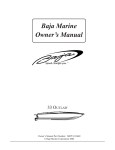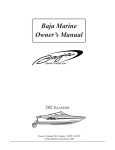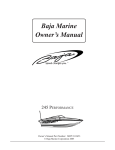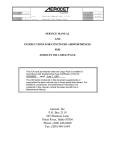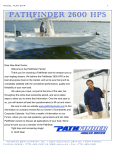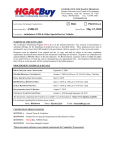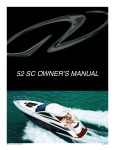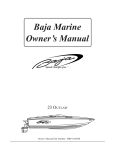Download Baja Marine Outlaw 33 Owner`s manual
Transcript
Baja Marine Owner’s Manual R Speed changes you. TM. 33 Outlaw Owner’s Manual Part Number: MRP 1813660 © Baja Marine Corporation 2006 Section 8 • Required Inspection, Service, & Maintenance 3. Inspection, Service and Maintenance Protocol A. Bilge Area Many of your boat’s systems have critical features located in the bilge area. A thorough and organized inspection of the bilge area will address many of these critical features. For example, engine oil leaks and fuel system leaks will show themselves as contamination on the surface of the liquid that remains in the bilge. When you see such contamination, you should look for its source. 2. Engine Engine failure or malfunction, when away from shore, can be dangerous. Make certain you do the following each time you use the boat: • Wipe off the engine to remove accumulated dust, grease and oil. • Check all exposed nuts, bolts and screws for tightness. • Once or twice a year, pump the bilge areas dry and remove all loose dirt. Be sure that all the limber holes are open. Limber holes are the openings in the stringers that allow water to flow from the outboard areas of the bilge to the bilge sump. Inspect the belts for wear. If they do not require replacement, check and adjust the belt tension according to the engine manufacturer’s recommendation. • Inspect engine wiring, and clean and tighten the terminals on the engine electrical system. • Clean and lubricate the battery cables. Check the bilge pump float switch by moving it manually. (Figure 4.1.2) The bilge pump should start when the float switch is raised and should stop when lowered. If it does not, have it replaced before using your boat. The float switch should also move freely without sticking, if it does not, have it serviced or replaced before boating. • ! WARNING DO NOT USE FLAMMABLE SOLVENTS to clean any part of the bilge. Fumes can accumulate and can be the source of an explosion. 1. Oil If there is oil contamination, look for leaks in engine oil lines and engine gaskets. If parts of the bilge have been stained by oil, the stain can be removed using a bilge cleaner available from your dealer or a marine store. 8.4 •Add distilled water to the battery cells as needed. Refer to your Engine Operator’s Manual for additional engine maintenance requirements. 3. Fuel System • Inspect the entire fuel system for evidence of leakage, including the fuel tank fill lines and vents. Any stain around a joint could be an indication of a leak. • Test all fittings with a wrench to be sure they are not loose, but do not forcefully overtighten the fittings. • Clean fuel filters and vent screens. ! WARNING Work on electrical wiring can create shock hazards or sparks. Always shut off battery switch, breakers and/or pull fuses before checking electrical wiring or connectors. 33 Outlaw® Section 8 • Required Inspection, Service, & Maintenance 4. Wiring System • Check your first aid kit, making certain it is complete and that the items in it have not passed an expiration date. • Check all wiring for proper support. • Check all wiring insulation for signs of fraying or chafing. • • Check all terminals for corrosion - corroded terminals and connectors should be replaced or thoroughly cleaned. Check the signaling equipment and emergency flares. Make sure all items are within their expiration dates. • Inspect the anchor, mooring, and towing lines. Repair or replace as required. Tighten all terminals securely and spray them with light marine preservative oil. • Check fire extinguishers for full charge. • 5. Fittings, Hoses and Clamps • Inspect the entire bilge area for evidence of damage or deterioration. Evidence of deterioration will first appear around hull fittings, hoses and clamps. 4. Winterization Checklist for Boats Stored on Land A. Boat Storage •Store boat in a bow high attitude. •Straighten kinked hoses. • Remove hull drain plug. • Replace any hose that does not feel pliable. • • Check all hose clamps for tightness and corrosion. Corroded clamps must be replaced. Pour one (1) pint (half-liter) of 50% water/ antifreeze mixture in each bilge pump sump. • Check the nuts, bolts and screws that retain equipment, hoses, etc. in the bilge for tightness and corrosion. Corroded fasteners must be replaced. B. Topside and Supplies Once a year, you should undertake a thorough review of the topside equipment, as well as of the critical safety supplies on your boat. • • • B. Engine •Flush engine with fresh water. • Remove engine drain plugs. Refer to your Engine Operator’s Manual for detailed information on preparing the engines for storage and winterization. C. Battery(ies) Check cleats, rings, rails, etc. for loose or corroded fasteners, breaks, sharp edges, or other conditions that could lead to malfunction or unsafe use. Repair or replace as necessary. • Remove from boat. Remove the negative (-) cable first, then the positive (+) cable. • Remove grease and dirt from top surface. Inspect PFDs (life jackets) for tears and deterioration. •Grease terminal bolts. Make certain you have enough PFDs on board for the maximum number of persons you can carry. 33 Outlaw® •Store on wooden pallet or thick plastic in a cool dry place. Do not store on concrete. 8.5 Section 8 • Required Inspection, Service, & Maintenance •Keep under a trickle charge. 5. Fitting Out After Storage • A. Fuel System When placing battery back into service, remove excess grease from terminals, recharge as necessary and reinstall in boat. D. Fuel Systems Gasoline: •Fill fuel tank with gasoline and the recommended amount of stabilizer and conditioner such as “Stabil®”. • Run engine(s) for ten minutes to ensure that all gasoline in the carburetor and fuel lines are treated. Diesel: •Fill fuel tank with diesel and recommended amount of biocide, “Biobor®”, which prevents bacteria and fungi from contaminating diesel fuel that contains some water. Check the entire fuel system for loose connections, worn hoses, leaks, etc. and repair. This is a primary safety precaution. Check fuel lines for damage and make sure that they do not come in contact with any moving parts. B. Battery(ies) Before installing the batteries, clean the terminal posts with a wire brush or steel wool and then attach the cables. After the cable clamps are tightened, smear the post and clamps with vaseline or grease to exclude air and acid. Do not apply grease before attaching and tightening the terminal clamps. Examine all wiring. C. Miscellaneous • Diesel fuel should also get a petroleum distillate additive, such as “Stabil®” or Racor® RX100”. This will absorb water in the fuel and prevent freezing problems. • Check all thru-hull fittings for unobstructed water passage. Be alert for any deteriorated hoses and/or fittings below the water line which might fail in service and allow water. • Run engine(s) for ten minutes to ensure that all diesel fuel in injectors and fuel lines is treated. • Test the navigation lights. • Check all wiring for loose connections. • Check all switches and equipment for proper operation. • Check bilge blowers for proper operation. Turn on blowers and place hand over hull blower vent to make sure air is coming from vent. D E TA I L E D W I N T E R I Z I NG , O P E R AT I NG INSTRUCTIONS AND WARRANTY INFORMATION ARE PROVIDED BY THE EQUIPMENT MANUFACTURER AND CAN BE FOUND IN THE OWNER’S PACKET. ! CAUTION Do not overfill. Filling a tank until the fuel flows from vents is dangerous. Allow room for expansion. 8.6 •Anchor lines and gear should be inspected and replaced if necessary. • Make sure the hull drain plug is in place and tight. • Clean bilge thoroughly if it was not done at lay-up. • Check all engine fluid levels. 33 Outlaw® Section 8 • Required Inspection, Service, & Maintenance • • Check fuel lines for damage and/or leaks. Make sure that they do not come into contact with moving parts. • Check Carbon Monoxide detector to see if operational Check all fittings, clamps, and bolts for tightness every month. • Check power steering pump drive belt for wear and proper tension every month. Do not overtighten belt. This can cause bearing failure. 6. Security Considerations Be conscious of the security of your boat. Always remove the keys from the ignition, lock hatches, lock the cabin door, remove and stow any removable electronic gear (fishfinders, LORAN, etc.) and personal gear (fishing poles, etc.) normally left aboard your boat. 7. Power Steering System Maintenance •Lubricate the control valve on the power steering cylinder through the grease fitting with multipurpose lubricant until grease appears around the rubber boot. • with hot engine parts. R E F E R TO T H E E NG I N E O P E R ATO R ’ S MANUAL FOR PROPER FLUID LEVELS AND LUBRICANTS. Baja® Marine recommends that all repairs and/or replacements to steering systems be made by qualified dealers authorized by manufacturer of the steering system of your boat. DETAILED OPERATING INSTRUCTIONS AND WARRANTY INFORMATION ARE PROVIDED BY THE EQUIPMENT MANUFACTURER AND CAN BE FOUND IN THE OWNER’S PACKET. Coat power assist steering output shaft and exposed steering cable end with appropriate lubricant. •Lubricate cable end guide pivot point with SAE 30W engine oil. • Check power steering fluid level in the power steering pump reservoir. • Inspect all hydraulic hoses for leaks. Keep hoses from rubbing on moving parts and from contact 33 Outlaw® 8.7 Section 8 • Required Inspection, Service, & Maintenance 8. Quick Reference Checklist As the owner/operator of a Baja® Boat, you are responsible for the safe operation of your boat and the safety of your passengers. Always be sure that required documents, navigational equipment and Coast Guard required safety equipment is aboard and in proper working order. A. Boarding the Boat* General 1. Weather Conditions................................................. Is it going to be safe to go out? 2. Transom Drain Plug................................................. Installed 3. PFDs and all other Coast Guard required safety equipment....................................... Available for all children and adults 4. Ignition keys............................................................. Available 5. Tool Box................................................................... Stocked with a variety of appropriate tools 4.Fire Exgtinguisher.................................................... Available 5. Cell Phone...............................................................Fully charged Boat Systems 1. Bilge Pumps............................................................ Working. Discharge any appreciable amounts of water overboard 2. Blowers.................................................................... Working. “Sniff” the bilge/engine compartment for fuel odor 3.Navigation Lights..................................................... Working. Have spare bulbs (and if applicable fuses) aboard 4. Radio/Electronics..................................................... Working 5.Horn......................................................................... Working 6. Trim Tabs................................................................. Full range of motion. No excessive play or binding 7.Fresh Water Tank ................................................... Filled and sanitized 8. Carbon Monoxide Detector...................................... Working Engine 1. Batteries.................................................................. Fully charged (Check water cell levels) 2.Fuel Tank................................................................. Filled with recommended fuel; not leaking 3.Fuel System............................................................. Check for leaks 4.Fuel Filters............................................................... Check that filters are clean and tight 5. Diesel Racor Fuel Filters......................................... Check that filters are clean, tight and free of water 6. Engine Coolant Drain Plugs.................................... Secured 7.Steering Fluid.......................................................... Full 8. Throttle & Gearshift Controls................................... Full range of motion *Note: If trailering boat, many of these items should be checked before leaving the house. 8.8 33 Outlaw® Section 8 • Required Inspection, Service, & Maintenance Quick Reference Checklist (cont’d) B. Preparing to Depart and After Launching General 1. Bilge/Engine Compartment...................................... “Sniff” the bilge/engine compartment for fuel odor. Run the bilge blowers for at least four (4) minutes. 2.Shore Power Cable................................................. Disconnected from dockside power inlet 3.Lines, Fenders and Anchor...................................... Ready for use 4. Passengers/Crew.................................................... Instructed in duties for getting underway and fitted for a correct size PFD Engine 1. Battery Switches...................................................... In the ON position 2.Fuel Valves (Diesel Only)........................................ Open 3. Engine Alarm........................................................... Test. Should sound after a few seconds 4.Gear Shift & Throttle Controls................................. In NEUTRAL and IDLE positions Starting the Engine* 1.Gearshift & Throttle Controls................................... Shift in NEUTRAL (Refer to your Engine Owner’s Manual for startup procedures for your specific engine) 2. Ignition..................................................................... Turn ignition keys on the helm clockwise until engine starts, then release. IMPORTANT: Do not continue to operate starter for more than 10 seconds without pausing to allow starter motor to cool off for 2 minutes. This also will allow the battery to recover between starting attempts.* ! WARNING Do not run the engine or generator in an enclosed area, such as a closed boat house, as there is the possibility of buildup and inhaling of carbon monoxide. *If engine fails to start, refer to the Engine Owner’s Manual for further troubleshooting procedures 33 Outlaw® 8.9 Section 8 • Required Inspection, Service, & Maintenance Quick Reference Checklist (cont’d) C. Departing General 1. Passengers/Crew.................................................... Safely seated with PFDs on or immediately accessible 2.Lines, Fenders and Anchor...................................... Stowed Boat Systems 1. Trim Tabs................................................................. Bring boat to “on plane” – Adjust as necessary 2.Navigation Lights..................................................... On at night or in reduced visibility Engine 1. Tachometers............................................................ Engines operating in safe RPM range 2. Engine Gauges........................................................ Continually monitor 3. Engine Operation..................................................... Check idle and shift. Listen for abnormal noises and visually check the engine compartment. D. Returning to Port General 1. Passengers/Crew.................................................... Instructed in duties for line handling 2.Lines and Fenders................................................... Ready for use Boat Systems 1.Navigation Lights..................................................... Turned OFF when secured 2.Anchor Light............................................................ ON if necessary 3. Bilge/Engine Compartment...................................... “Sniff” the bilge/engine compartment for fuel odor. Run the bilge blowers if necessary. Check for water in bilge. Run bilge pumps if necessary Engine 1.Gearshift & Throttle Controls................................... Bring to NEUTRAL and IDLE positions 2. Tachometers............................................................ Idle the engines for five (5) minutes to cool down 8.10 33 Outlaw® Section 8 • Required Inspection, Service, & Maintenance Quick Reference Checklist (cont’d) 3. Ignition..................................................................... Once the motor is cooled down, turn the ignition keys counter clockwise to stop the engine. 4. Engine Operation..................................................... Check idle and shift. Listen for abnormal noises E. Securing the Boat General Lines and Fenders......................................................... Fenders in place, lines tied securely to dock Boat Systems 1.Helm Switch Panel.................................................. All switches in the OFF position 2.Gearshift & Throttle Controls................................... In the NEUTRAL and IDLE positions Engine 1. Ignition..................................................................... Switch is in the OFF position and ignition keys are removed 2. Battery Switches...................................................... In the OFF position 3.Fuel Valves (Diesel Only)........................................ Closed (handle perpendicular to hose) F. If the Engine Does Not Start No Starter Motor Response 1. Check battery switch is in the ON position. 2. Check the main circuit breaker. 3. Check gearshift/throttle control levers in the NEUTRAL positions. 4. Check battery condition for sufficient charge. 5. Check battery cable connections tight and free from corrosion. 6. Check starter motor and solenoid connections. 7. Check ignition switch connections. 8. Consult the engine manual that is located in the owners packet. Starter Motor Responds, but No Ignition 1. Check that fuel tank is not empty. 2. Check that ignition shutdown switch lanyard is installed. 3. Check electrical connections on engine wiring harness and ignition wiring. 4. Check fuel filters and filter/water separators clean 5. Consult the engine maual that is located in the owners packet. 33 Outlaw® 8.11 Section 8 • Required Inspection, Service, & Maintenance 9. After Market Equipment Checklist Any safety or operational equipment added to your boat after delivery should be checked for seaworthiness and proper working condition. Use the area below to list any equipment and the proper operating condition of that equipment before getting underway. Equipment 8.12 Proper Operating Condition 33 Outlaw® Section 8 • Required Inspection, Service, & Maintenance 10. Maintenance Log Follow the recommended maintenance listed on pages 1 & 2 of this section and keep a record of this and ALL maintenance performed on your boat. Date 33 Outlaw® Maintenance Description Engine Hours 8.13 Section 8 • Required Inspection, Service, & Maintenance Maintenance Log (Cont’d) Date 8.14 Maintenance Description Engine Hours 33 Outlaw® Section 9 • Care & Refinishing Your new boat has been designed to provide you with years of enjoyment and satisfaction. In order to maintain the factory new appearance of your boat, we recommend the use of Yacht Bright™ products designed specifically for pleasure boats. Following proper fiberglass maintenance guidelines will help maintain your boat’s performance, value, and enjoyment. 1. Paint Cleaning Agents & Other Substances Wash the gelcoat and fiberglass regularly with clean, fresh water. Wax gelcoated surfaces to maintain the luster. In northern climates, a waxing at the start and end of the boating season may suffice. In southern climates, an application of wax every three months will be required for adequate protection. REFER TO THE Yacht Bright™ PAMPHLET IN YOUR OWNER’S MANUAL PACKET FOR INSTRUCTIONS AND WARRANTY INFORMATION. 3. Stains & Scratches ! WARNING ! WARNING EXPLOSION/FIRE HAZARD Gelcoat surfaces are slippery when wet. Care and refinishing materials may contain ingredients that are flammable or explosive. Do not use such materials in the bilge Always wear non-slip footwear securely fastened to your feet and hold on to rails or the boat structure. Shut off electrical power and ventilate when using such materials anywhere on the boat or in the cabin. ! WARNING Do not create sparks or use lighted materials. Waxed surfaces are slippery. Do not wax areas that are usually walked on. Do not use products containing chlorine, phosphates, perfumes and non-degradable ingredients. Consult your marine dealer regarding environmental regulations before painting the hull. Fumes can last for hours, and chemical ingredients can harm people, property and the environment. Common household cleaning agents may cause hazardous reactions. Read and understand directions on all paint, cleaning and polishing materials before using. 2. Fiberglass & Gelcoat The fiberglass hull, deck and some interior parts consist of a molded shell and exterior gelcoat. The gelcoat is the outer surface, often colored, that presents the shiny smooth appearance associated with fiberglass products. This gelcoat surface is painted or taped in some areas for styling purposes. 33 Outlaw® Although gelcoat and painted surfaces are resistant to deep stains, a need for cleaning will occasionally arise. But, the use of some common cleaning agents will permanently discolor or otherwise damage the finish on your boat. • Do not use abrasive porcelain-cleaning powders. These are too abrasive and contain chlorine and ammonia, either of which will permanently discolor gelcoat and paint. •Never use nail polish remover (acetone) or any ketone solvents. • Use diluted household detergents to remove surface soil and stains. Before using a given brand, check to make sure it contains no chlorine or ammonia. • Isopropyl alcohol can be used to remove difficult stains. But it must be promptly washed off with mild detergent and water. 9.1 Section 9 • Care & Refinishing • Minor scratches and deeper stains that do not penetrate the gelcoat may be removed by light sanding and buffing. 4. Permanently Moored or Docked Boats If permanently moored in salt water or fresh water, your boat will collect marine growth on its bottom. This will detract from the boat’s beauty and greatly affect its performance. There are two methods of preventing this: • • Periodically haul the boat out of the water and scrub the bottom with a bristle brush and a solution of soap and water. Paint the hull below the waterline with a good grade of antifouling paint. DO NOT paint the engine drive surfaces. NOTE: There are EPA regulations regarding bottom paint application. Consult your Baja® dealer for proper application methods. 5. Topside Areas A. Stainless Steel and Alloy Fittings Stainless steel and alloy fittings should be cleaned with soap and water or household glass cleaner. Remove rust spots as soon as possible with a brass, silver or chrome cleaner. Irreversible pitting will develop under rust that remains for any period of time. Never use an abrasive like sandpaper or steel wool on stainless. These may actually cause rust. To help protect the stainless, we recommend the use of a good car wax. B. Salt Crystals When instruments are exposed to a saltwater environment, salt crystals may form on the bezel and the plastic covers. These salt crystals should be removed with a soft, damp cloth; never use abrasives or rough, dirty cloths to wipe plastic parts. Mild household detergents or plastic cleaners can be used to keep the instruments bright and clean. Refer to the Owner’s Manual Packet for instructions and warranty information. 9.2 6. Acrylic Plastic Sheeting (Plastic Glass) Never use a dry cloth or duster or glass cleaning solutions on acrylic. To clean acrylic, first flood it with water to wash off as much dirt as possible. Next, use your bare hand, with plenty of water, to feel and dislodge any caked dirt or mud. A soft, grit-free cloth may then be used with a nonabrasive soap or detergent. A soft sponge, kept clean for this purpose, is excellent. Blot dry with a clean damp chamois. Grease and oil may be removed from acrylic with kerosene, hexane, white (not aviation or ethyl) gasoline or aliphatic naphtha (no aromatic content). Do not use solvents such as acetone, silicone spray, benzine, carbon tetrachloride, fire extinguisher fluid, dry cleaning fluid or lacquer thinner on acrylic, since they attack the surface. Remove fine scratches with fine automotive acrylic rubbing and polishing compounds. 7. Canvas and Clear Vinyl Do not fold or store any of the canvas pieces while wet. All canvas should be rolled or folded when dry and stored in a clean, dry place. For clear vinyl pieces, the recommended methods for storage are rolling or laying down flat. The clear vinyl should never be folded or creased as cracking will result. To protect the clear vinyl from rubbing against itself while rolled or stored flat, place a piece of very soft, nonabrasive cloth between the pieces. If the surface of the clear vinyl becomes scratched, the canvas manufacturer has provided a canvas care sheet located in your Owner’s Manual Packet. When storing the rear (aft) curtain, fold the canvas over the clear vinyl window (do not fold clear vinyl), then roll or store flat. Refer to the canvas care instructions in the Owner’s Manual Packet. 33 Outlaw® Section 9 • Care & Refinishing The fabric should be cleaned regularly before substances such as dirt, pollen, etc. are allowed to accumulate on and become embedded in the fabric. The fabric can be cleaned without being removed from the installation. Simply brush off any loose dirt, particles, etc.; hose down and clean with a mild solution of a natural soap in lukewarm water (no more than 100°F, 38°C); rinse thoroughly to remove soap. DO NOT USE DETERGENTS. Allow to completely dry. Wash and clean vinyl windows with a warm soap solution. Use a soft cloth or sponge and do not scratch the surface. If you have stubborn cleaning cases, call your dealer for proper procedures. Do not try your own cleaning procedures as they may permanently damage the canvas. After each use, especially in salt water areas, rinse the canvas completely with fresh cold water. Then let the canvas dry completely before stowing. DO NOT, at anytime, dry any canvas part in a conventional dryer, because shrinking may occur. All metal components of the canvas should be rinsed with fresh cold water and exposed components wiped dry to maintain appearance and working order. 33 Outlaw® 8. Exterior Upholstery Fabric Exterior fabrics should be cleaned with a sponge or very soft scrub brush and a mild soap and warm water solution. After scrubbing, rinse with plenty of cold, clean water and allow the fabric to air dry in a well ventilated place, preferably away from direct sunlight. Mildew can occur if your boat does not have adequate ventilation. Heat alone will not prevent mildew; you must also provide for fresh air circulation. REFER TO THE OWNER’S MANUAL PACKET FOR INSTRUCTIONS AND WARRANTY INFORMATION. 9. Interior Upholstery Fabric Cleaning and maintenance information, provided by the material manufacturer, is in your Owner’s Manual Packet. REFER TO THE OWNER’S MANUAL PACKET FOR INSTRUCTIONS AND OTHER CLEANING INFORMATION. NOTICE Always clean spots, stains, etc., immediately. Test an unseen area of fabric before cleaning stain, to insure that cleaning material will not cause damage. 9.3 Section 9 • Care & Refinishing This Page Intentionally Left Blank 9.4 33 Outlaw® Index A Accessories. See Options & Accessories Locations B Bilge 4.1 Blower 4.2 Maintenance 4.2, 8.4 Pump 4.1 Boarding 3.3 Breakers. See Electrical Systems C Canvas 7.2, 9.2 Carbon Monoxide 1.2 Certifications CE (Common European) Mark iv Clearances 2.2 Fuel System Anti-Siphon Valve 5.1 Fuel Gauge 2.8 Fueling 3.2 Maintenance 8.4 Fuses. See Electrical Systems R G S Gear Shift and Throttle Control 2.5 Gelcoat, Care & Cleaning 9.1 Safe boating 1.1 Safety Labels 1.1 Security Considerations 8.7 Service, Summary Guide 8.1 Service Information 8.3 Skiing 1.9 Stability 1.7 Stains 9.1 Steering System 3.6 Stern Drive 4.2 Storage 2.1 Swimming 1.9 Swim Platform 7.3 Symbols 1.16 H Head System 7.4 Holding Tank 7.5 Horn 7.3 Hull Indentification Number (HIN) iv I D Ignition Shutdown Switch 2.7 Diving 1.10 Docking 2.1 L E Electrical Systems Batteries 6.1 Breakers and/or Fuses 6.2 Direct Current (DC) 6.1 Electrolytic Corrosion 6.2 Emergency Situations 1.10 Engine Maintenance 8.4 Maintenance & Service 4.2 Starting 3.4 Stopping 3.5 Engine Alarm System 2.7 Exhaust System 7.5 F Failure: Propulsion, Control or Steering 1.12 Fiberglass, Care & Cleaning 9.1 Fire Extinguisher 1.2 Fire Extinguisher Port 7.2 Fire Extinguishing System 1.2, 7.2 Flooding 1.11 33 Outlaw® Layout Deck 2.4 Lifting 2.1 Lights Navigation & Anchor 2.8 Load Capacity 1.6 N Nautical Terms 1.15 O OEM i Options & Accessories Locations 7.1 Owner’s Manual Packet i P Passengers Instruction 3.4 Locations 2.1 Personal Flotation Devices (PFDs) 1.2, 1.4, 3.3 Power Capacity 1.6 Power Trim 2.5 Propellers 1.6, 2.3 Removal & Installation 4.3 Propulsion System 2.3 Recommended Equipment 1.5 Requirements International Requirements 1.13 Required Equipment 1.2 T Tachometer 2.7 Trailering 2.1 Trailer Launching and Loading 3.2 Trailer Switch 2.6 Trim 2.5 Trim Tabs 2.6 U U.S. Coast Guard 1.12 V Visual Distress Signals 1.2 W Warranty iii, v Water Sports 1.9 Water Temperature 2.8 Weather 1.8 Winterization 8.5 Z Zinc Anodes 6.2 Index This Page Intentionally Left Blank Index 33 Outlaw®


















